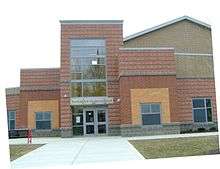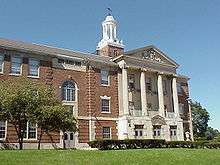Columbus City Schools
| Columbus City Schools | |
|---|---|
| Location | |
|
Columbus, Ohio USA | |
| Coordinates | 39°59′N 82°59′W / 39.983°N 82.983°WCoordinates: 39°59′N 82°59′W / 39.983°N 82.983°W |
| District information | |
| Step up, Make it happen | |
| Established | 1845 |
| Superintendent | J. Daniel Good, Ph.D. |
| Students and staff | |
| Students | 56,000+ (Aug 2006) |
| Teachers | 4,166 (Oct 2007) |
| Staff | 7,181 FTE (Oct 2007) |
| Athletic conference | OHSAA |
| Other information | |
| Website |
ccsoh |
Columbus City Schools, formerly known as Columbus Public Schools, is the official school district for the city of Columbus, Ohio, and serves most of the city (portions of the city are served by suburban school districts). The district has over 56,000 students enrolled, making it the largest school district in the state of Ohio as of August 2006. At its peak during the 1971 school year the district served 110,725 students.
The first school built in the area which is now part of Columbus was a log cabin school-house built in Franklinton, in 1806. It wasn't until 1845 that the state of Ohio Legislature entrusted the management of Columbus schools to a Board of Education. Two years later the school board elected Dr. Asa Lord as the district's first superintendent. Dr. Gene T. Harris served as the 19th superintendent of Columbus City Schools and was succeeded by Dr. Dan Good. For most of its history, the district has been referred to as "Columbus Public Schools". In August 2007, the district decided to begin using its official name of "Columbus City Schools."
1977 Desegregation
Although technically the landmark Brown v. Board of Education case made segregation in schools illegal, some schools were still segregated by the neighborhoods they served. In March 1977 Federal District Court Judge Robert M. Duncan ruled in Penick v. Columbus Board of Education that the school boundary methods used by Columbus Public Schools promoted segregation by sending black students to predominantly black schools and white students to predominantly white schools. The result was forced busing to desegregate all schools in the Columbus Public School district.
Before the 1978-1979 school year the Columbus Public School district petitioned Supreme Court Justice William Rehnquist for a stay on the forced busing, and the petition was granted. However, in April 1979 the Supreme Court made their decision and upheld the original Duncan decision.
Before this landmark decision was handed down, the district had a peak of 110,725 students enrolled in 1971 and operated 20 high schools. Many parents moved their children out of the Columbus district to the suburbs to avoid the desegregation. As a result, district enrollment significantly declined, forcing two high schools, Central High School (In 1982) and North High School (In 1979) to be closed, as well as several elementary and middle schools.
School Enrollment
Enrollment figures in the school district have significantly increased in the past and recently decreased. Following is a list of school enrollments over the years.[1]
| Year | Enrollment |
|---|---|
| 1920 | 32,442 |
| 1947 | 40,000 (Estimate) |
| 1962 | 93,000 (Estimate) |
| 1971 | 110,725 (All-Time Peak) |
| 1976 | 95,571 |
| 1980 | 72,698 |
| 1995 | 62,812 |
| 1996 | 63,610 |
| 2007 | 55,235 |
| 2012 | 50,784 |
Board of education
There are 7 members on the Board of Education. Current members are listed below:[2]
- Gary L. Baker, II - President
- Eric S. Brown
- Michael Cole
- W. Shawna Gibbs
- Mary Jo Hudson
- Dominic Paretti
- Ramona R. Reyes
Schools
There are a total of 118 active schools in the district.
Elementary schools

- Alexander Graham Bell Elementary School
- Alpine Elementary School
- Avalon Elementary School
- Avondale Elementary School
- Beatty Park Elementary School
- Berwick Alternative Elementary School
- Binns Elementary School
- Broadleigh Elementary School
- Burroughs Elementary School
- Cassady Alternative Elementary School
- Cedarwood Alternative Elementary School
- Clinton Elementary School
- Colerain Elementary School
- Como Elementary School
- Cranbrook Elementary School
- Devonshire Alternative Elementary School
- Duxberry Park Alternative Elementary School
- Eakin Elementary School
- East Columbus Elementary School
- East Linden Elementary School
- Eastgate Elementary School
- Easthaven Elementary School
- Fairmoor Elementary School
- Fairwood Alternative Elementary School
- Forest Park Elementary School
- Gables Elementary School
- Georgian Heights Alternative Elementary School
- Hamilton Alternative Elementary School
- Highland Elementary School
- Hubbard Mastery Elementary School
- Huy Road Elementary School
- Indian Springs Elementary School
- Indianola Alternative Elementary School
- Innis Elementary School
- Leawood Elementary School
- Liberty Elementary School
- Lincoln Park Elementary School
- Lindbergh Elementary School
- Linden Elementary School
- Livingston Avenue Elementary School
- Maize Road Elementary School
- Moler Elementary School
- North Linden Elementary School
- Northtowne Elementary School
- Oakland Park Alternative Elementary School
- Oakmont Elementary School
- Ohio Avenue Elementary School
- Olde Orchard Alternative Elementary School
- Parkmoor Urban Academy Elementary School
- Parsons Elementary School
- Salem Elementary School
- Scottwood Elementary School
- Shady Lane Elementary School
- Siebert Elementary School
- South Mifflin Elementary School
- Southwood Elementary School
- Special Education Center
- Stewart Alternative Elementary School
- Sullivant Elementary School
- Trevitt Elementary School
- Valley Forge Elementary School
- Valleyview Elementary School
- Watkins Elementary School
- Weinland Park Elementary School
- West Broad Street Elementary School
- West Mound Elementary School
- Westgate Alternative Elementary School
- Windsor Alternative Elementary School
- Winterset Elementary School
- Woodcrest Elementary School
- Columbus Spanish Immersion
- Ecole Kenwood
Middle schools

- Arts Impact Middle School (AIMS)
- Buckeye Middle School
- Champion Middle School
- Columbus City Preparatory School for Boys
- Columbus City Preparatory School for Girls
- Columbus Gifted Academy
- Dominion Middle School
- Hilltonia Middle School
- Johnson Park Middle School
- Medina Middle School
- Mifflin Alternative Middle School
- Ridgeview Middle School
- Sherwood Middle School
- Starling Middle School K-8 (Original West High School)
- Wedgewood Middle School
- Westmoor Middle School
- Woodward Park Middle School
- Yorktown Middle School
K-8 Alternative Schools
- Africentric K-8
- Columbus Spanish Immersion Academy at Beaumont Elementary School
- Ecole Kenwood French Immersion School at Kenwood Elementary School
- Indianola Informal K-8
- Starling K-8 School (merger of Dana Elementary and Starling Middle in 2013)
High schools


- Beechcroft High School
- Briggs High School
- Centennial High School
- Columbus Africentric High School
- Columbus Alternative High School
- Columbus North International School
- Downtown High School[3]
- East High School
- Eastmoor Academy
- Fort Hayes Metropolitan Education Center
- Independence High School
- Linden-McKinley High School
- Marion-Franklin High School
- Mifflin High School
- Northland High School
- South High School
- Walnut Ridge High School
- West High School
- Whetstone High School
Former Schools
- Barrett Middle School (1900-2006) - Original South High School building (Named for South's 1st Principal Charles S. Barrett 1900-1920)
- Barnett School - Closed 1977
- Beaumont Elementary School, now Columbus Spanish Immersion Academy
- Beck Urban Academy Elementary School
- Bellows Avenue School - Closed 1982
- Brentnell Alternative Elementary - now the Ohio Dominican University's Charles School
- Broadview School
- Brookhaven High School closed May 2014
- Calumet School-Closed as a Columbus City School, however is now a private Christian school
- Central High School (1924-1982) - Current site of COSI
- Chicago Avenue School
- Clarfield Elementary School
- Clinton Middle School
- Courtright Elementary School
- Crestview Middle School - now Indianola Informal K-8 School
- Eastwood Elementary School
- First Avenue School
- Franklin Alternative Middle School
- Fulton School
- Gladstone School
- Glenmont School
- Hamilton School
- Hudson Elementary School
- James Road Elementary School
- Kent Elementary School
- Kingswood School
- Koebel Elementary School
- Lane Avenue School
- Leonard Avenue School
- Linden Park Alternative Elementary - Closed 2007
- Linmoor Middle School - Closed 2007
- Main Street Elementary School
- Marburn Elementary School
- McGuffey Elementary School
- Medary Elementary School - Closed 2007
- Michigan Avenue School
- Milo Public School (1894-1977)
- Neil Avenue School (Open Air School)
- Ninth Avenue School
- North High School (1924-1979) - Bishop Watterson rents use of the stadium for football games; Columbus North International School is located there now
- Northridge School
- Northwood Avenue School
- Pilgrim Elementary School
- Pinecrest Elementary School
- Reeb Avenue Elementary School
- Scioto Trail Elementary School
- Sharon School
- Stockbridge Elementary School
- Third Street School
- Walford Elementary
2006-2007 Report Card
For the 06-07 school year, the district improved its rating to "Continuous Improvement" on the department of education's rating scale. The district met 42 of 42 adequate yearly progress goals, which allowed the rating to improve.
Columbus City Schools: By the Numbers
The Columbus City School District does not discriminate based upon sex, race, color, national origin, religion, age, disability, sexual orientation, gender identity/expression, ancestry, familial status or military status with regard to admission, access, treatment or employment. This policy is applicable in all district programs and activities.
Students: 50,809[4] Expenditures per student: $13,674
...by gender Male: 51.0% Female: 49.0% ...by ethnicity African-American: 58.07% Caucasian: 25.58% Hispanic: 6.74% Multi-racial: 5.29% Asian: 2.09% American Indian/Native Alaskan: 0.2% ...about our students Languages spoken at home: 89 Speak English as a second language: 11.5% Have Limited English Proficiency: 9.5% Receive district ESL services: 6.4% Students transported by CCS daily: 32, 140 Identified as Gifted & Talented: 17.7% Receive Special Education services: 16.06% Receive a free or reduced-price meal: 68.93% Student Mobility Rate: 19.7% Average Daily Attendance: 94.5%
Schools: 118
...by grade level Elementary (K-5): 63 STEM Elementary Academies (PreK-6): 4 K-6: 6 K-8 Schools: 4 K-12 Schools (Africentric Early College): 1 Middle Schools (grades 6-8): 18 STEM Academy 7-12 (Linden-McKinley): 1 High School/Middle School 7-12 (South): 1 ESL Welcome Center (grades 6-12): 1 High Schools (grades 9-12): 16 Career Centers: 2 Special Services Schools: 3
Staff: 6,571 (FTE)#
Staff demographics as of June 2011: by gender Male: 28.5% Female: 71.5% ...by ethnicity Caucasian: 62.6% African-American: 35.3% Hispanic: 1.2% Asian: 0.7% American Indian/Native Alaskan: 0.2%
References
- ↑ Jacobs, Gregory S. (1998). Getting Around Brown: Desegregation, Development, and the Columbus Public Schools. Columbus, Ohio: Ohio State University Press. ISBN 9780814207208.
- ↑ "Columbus Board of Education, 2016". Columbus City Schools. Retrieved 20 January 2016.
- ↑ Sebastian, Simone (January 5, 2009). "Completed Schools Set for Students". The Columbus Dispatch. GateHouse Media. Retrieved 15 August 2015.
- ↑ October 2011 EMIS data
- ↑ http://www.columbus.k12.oh.us/website.nsf/(ccs_pages)/CCS_By_the_Numbers?opendocument